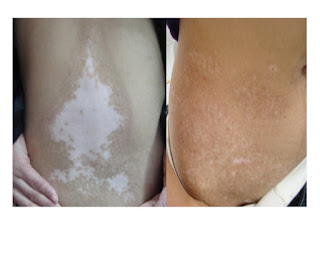Vitiligo is quite a common condition which makes the skin, and sometimes the
hair, turn white in patches. This is because melanocytes, the cells which give
the skin its colour, have been damaged.
Vitiligo is a auto-immune disease.Unfortunately, doctors still have not been able to point out the exact cause for this condition. What doctors try to do instead is boost the melanin production in body and restore the skin color.
Vitiligo is not contagious. If you have the condition, you cannot pass it on to someone else by touching them and it is not infectious. Vitiligo is considered to be an ‘autoimmune’ condition in which the immune system attacks the body’s own tissues.
The most common form of vitiligo appears in symmetrical form (generalised vitiligo) affecting both sides of the body. In some cases only one half of the body is affected (segmental vitiligo); this type has limited progression and is more difficult to treat. Vitiligo can spread to cover the entire body surface (universal vitiligo) but this is not usual.
The way the condition develops varies from one person to another and it is unpredictable. Some people may not notice a change in their condition for many years; for others it can spread quite quickly. In some cases, the white patches can regain their colour without the person having any treatment. This is more likely with children. However, it is very unusual for the condition to be resolved completely without treatment.
Vitiligo affects at least one person in every hundred throughout the world, including in the UK.
Anyone can develop the condition, whatever their skin colour or ethnic origin.
Vitiligo can begin at any age but about 50% of people develop it before the age of twenty.
Vitiligo is a auto-immune disease.Unfortunately, doctors still have not been able to point out the exact cause for this condition. What doctors try to do instead is boost the melanin production in body and restore the skin color.
Vitiligo is not contagious. If you have the condition, you cannot pass it on to someone else by touching them and it is not infectious. Vitiligo is considered to be an ‘autoimmune’ condition in which the immune system attacks the body’s own tissues.
The most common form of vitiligo appears in symmetrical form (generalised vitiligo) affecting both sides of the body. In some cases only one half of the body is affected (segmental vitiligo); this type has limited progression and is more difficult to treat. Vitiligo can spread to cover the entire body surface (universal vitiligo) but this is not usual.
The way the condition develops varies from one person to another and it is unpredictable. Some people may not notice a change in their condition for many years; for others it can spread quite quickly. In some cases, the white patches can regain their colour without the person having any treatment. This is more likely with children. However, it is very unusual for the condition to be resolved completely without treatment.
Vitiligo affects at least one person in every hundred throughout the world, including in the UK.
Anyone can develop the condition, whatever their skin colour or ethnic origin.
Vitiligo can begin at any age but about 50% of people develop it before the age of twenty.

